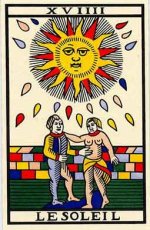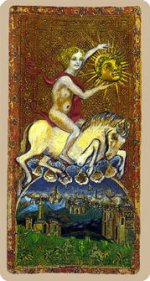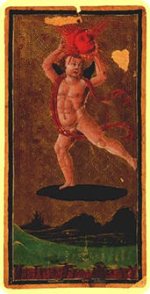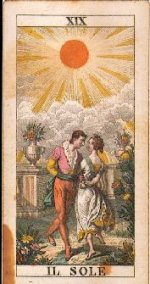jmd
xviiii Le Soleil
Unlike the Moon card, which has had a reasonable consistency of detail in its twin-tower, crayfish, pond, twin animal, and droplets falling towards to Moon depiction, the Sun card appears to have had more variations in various details, as well as major variations in its Marseilles vs northern depictions (from which the Waite/Coleman-Smith derives).
In some (Marseilles) decks, the droplets head towards the Sun, on others, towards the ground. On some decks, the two people appear as children - or at least genderless - on others, clearly of specific genders.
The card also has a consistent representation of a low stone/brick wall, and the two persons are clearly in touch with each other.
Attached, to introduce the post, is the reconstituted 1650 Noblet version, upon which one can clearly see male and female, and upon which the drops are heading towards the Sun.
Unlike the Moon card, which has had a reasonable consistency of detail in its twin-tower, crayfish, pond, twin animal, and droplets falling towards to Moon depiction, the Sun card appears to have had more variations in various details, as well as major variations in its Marseilles vs northern depictions (from which the Waite/Coleman-Smith derives).
In some (Marseilles) decks, the droplets head towards the Sun, on others, towards the ground. On some decks, the two people appear as children - or at least genderless - on others, clearly of specific genders.
The card also has a consistent representation of a low stone/brick wall, and the two persons are clearly in touch with each other.
Attached, to introduce the post, is the reconstituted 1650 Noblet version, upon which one can clearly see male and female, and upon which the drops are heading towards the Sun.






